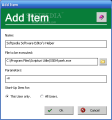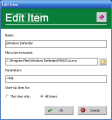The time it takes your system to boot depends on the number of items present in the system startup list. Basically, it is like this: the more the components to open at startup, the longer the time to load the operating system. Most of the times, it is really not necessary to start all of the most used applications at once, even if we are at the office, where we have specific programs to work with. I’m not saying that we can’t, but this will also depend directly on the system’s hardware configuration. A powerful CPU with enough RAM will do the job but, usually, at the office the computers are not blessed with spectacular specifications, unless this is an absolute requirement.
To gain time in system boot you have a few simple rules to follow: leave only the items that you really need in startup, like antivirus or mail client; install a small application that enables you to create a startup order, to gain time and manage resources; install a program that lets you set up a delay time for every item. Depending on your needs, these three small rules can make Windows boot faster. The Start-Up Tool application is a small startup item editor that was designed to help you add new entries, as well as remove or disable startup items.
Start-Up Tool ver.1.2 is very small (about 100KB) and requires no installation so it can be easily used as a portable application. The User Interface is basically the main window, from where you can manage the startup items, and, once launched, the program will display all the startup entries. Adding a new item is very easy, and the window designed precisely for that will allow you to enter a name, select the EXE file, as well as add parameters.
What’s really great is that the application will add the item either for the current user or for all of them. The first test that I made was to add a shortcut (of Start-Up Tool itself, and not the EXE file) in the startup folder (Start-Programs-Startup) to see whether or not it will be displayed. In the main window of Start-Up Tool there is a refresh button that allows the application to re-index the startup list, so that new items are added.
Also in the main window you can see a few details about every item: Location will show the path of the corresponding startup registry, Command will show the path to the executable and parameters (if available), Description will show the name and company that developed the product as well as that of the manufacturer (if found). The details can help you see if any malicious or unwanted items were added to startup.
Too bad that Start-Up Tool will not show the services too (use msconfig command: Run-msconfig to display them), but in many cases it is recommended because, if you are not very sure of the nature of the services and you remove one, after reboot Windows can become unstable or even fail to load.
Another important feature that needs to be mentioned is the possibility to create an HTML document, more like a list, that contains all the startup items. As I was saying before, you can distinguish between entries by using details. This list will allow you to preview the details in a more elegant way using a browser (the list will also display the item status: disabled/enabled along with the rest of the information). I was very pleased to find out that, despite the fact the we’re dealing with a small-sized application, the developer included a great help file that explains every button and action.
If you have more than one user and decide to add your regular applications to startup, assuming that system resources can handle the peak, Start-Up Tool will display the type of every item; the type refers to USR (current user) or ALL (all users). It is good to know that even if the number of items increases, Start-Up Tool can help you display the ones you want. To permanently remove the corresponding disabled item registries Start-Up Tool includes a cleanup function. Beware that after pressing the CleanUp button and after the warning message, the action cannot be undone.
 14 DAY TRIAL //
14 DAY TRIAL // 




